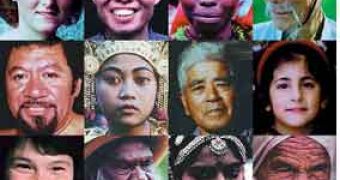It has already been predicted that by the end of the century, half of the languages spoken now worldwide will be gone. Not by evolving into another language (like Latin into Italian, Spanish, French or Romanian), but by being wiped out by other languages. A team has detected five global "hot spots" of indigenous language extinction, with northern Australia and the center of South America being on top.
The Enduring Voices project looks to document and revitalize doomed languages, like those of the Australian aborigines whose cultures have been trampled by European settlers and English.
"There are 6,992 recognized distinct languages worldwide. On average one language vanishes every two weeks, often as its last elderly speakers perish." said project's co-director, David Harrison of Swarthmore College in Pennsylvania.
The project supported by National Geographic magazine found northern Australia (Queensland, Northern Territory and Western Australia) as the world's location with the highest number of threatened languages, about 153. The area of central South America covering Ecuador, Colombia, Peru, Brazil and Bolivia was the second, with indigenous languages being eliminated by Spanish, Portuguese or some indigenous languages.
Bolivia, with an area of Spain and France combined, and just 9 million inhabitants, has a double number of languages than in whole Europe, but most of the smaller tongues are eliminated now by Spanish, Quechua (the language of the Inca) and Aymara (the last two being indigenous languages).
In North America, the hot spots are made by British Columbia (Canada), Washington and Oregon (US) on one side (the third place in the world), and Oklahoma, Texas and New Mexico(US) on the other side (the fifth place in the world). Eastern Siberia makes the fourth "hot spot."
"There are quite a few languages, dozens if not hundreds, that are down to one, two or three speakers, or maybe even they've lost their last fluent speakers but have a few 'semi-speakers' who have a passive knowledge of the language. We're going to lose an immense storehouse of knowledge," said Harrison, pointing that precious data gathered over centuries about various living species are found in languages of native peoples.
"Many languages have no written form, meaning that they are lost forever when their last speaker dies," Harrison said. "Languages often trickle out of existence rather than sort of abruptly disappearing," said Gregory Anderson, co-director of the Enduring Voices project and director of the nonprofit Living Tongues Institute for Endangered Languages.
Historically, many languages have been deliberately eliminated by colonizers or new occupants.
"Children now often decide a language's fate, by abandoning an ancestral tongue for another language they see as more widely used, for example, on television or in school." said Harrison.
The Enduring Voices project tries to record extinguishing languages by interviewing their last speakers.
"We'll start with a basic 100- or 200-word list. And then we'll go over each word with them again to make sure that we're transcribing it correctly, and try to repeat it to them. And usually they'll burst out laughing at that point because we have hideously mispronounced it ... or make some word that sounds obscene to them. ... I did that in Australia, I'm afraid," said Anderson.

 14 DAY TRIAL //
14 DAY TRIAL //